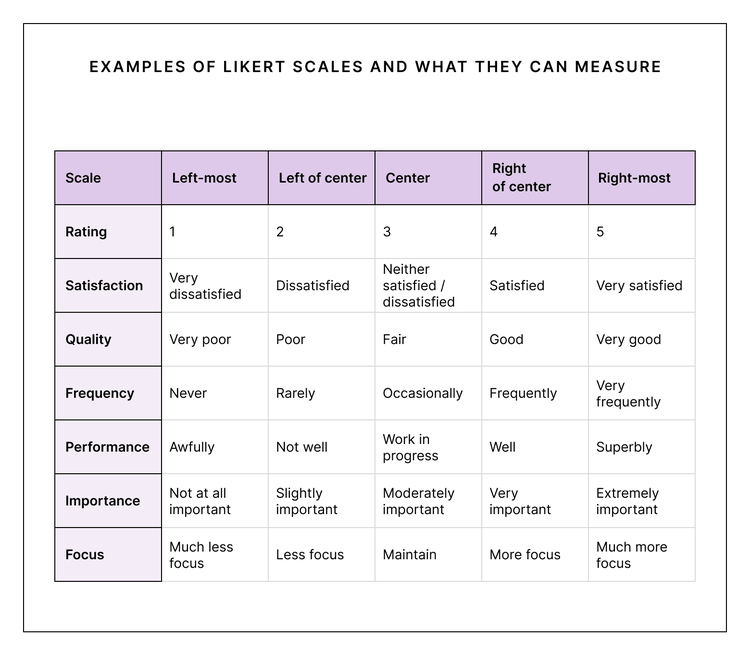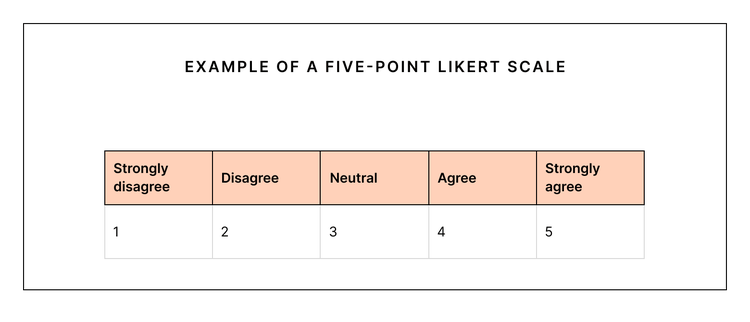
Likert scale: How to use the popular survey rating scale

Measuring something as intangible as employee sentiment is challenging. Would you strongly disagree, disagree, neither disagree nor agree, agree, or strongly agree with that statement?
Just like that, you’ve taken a survey that uses a Likert scale! This popular survey rating scale can help businesses quantify even abstract concepts like employee attitudes, beliefs, and perceptions with a simple response from 1 to 5.
In this article, we explore what a Likert scale is, how to use these scales in different workplace surveys, and how they help businesses better understand their employees. Plus, we’ll share Culture Amp’s people science-backed approach to using Likert scales in surveys to collect meaningful feedback at scale.
What is a Likert scale?
Developed in 1932 by Rensis Likert, a Likert scale measures attitudes by having respondents express the degree to which they agree or disagree with a statement. Each scale typically consists of five or seven options for participants to choose from and fundamentally seeks to evaluate whether employees’ feelings are favorable, neutral, or unfavorable about each statement.
Here’s what these responses typically look like:
Favorable
- Strongly Agree
- Agree
Neutral
- Neither Agree nor Disagree
Unfavorable
- Disagree
- Strongly Disagree
In addition to measuring the degree of agreement, a Likert scale can also be used to measure satisfaction, quality, frequency, performance, importance, and focus:

While these examples include five-point scales, they would also work as seven-point scales. If your business needs a more nuanced measurement of employee sentiment, the seven-point scale gives your employees more options to choose from to convey their points of view accurately. That said, at Culture Amp, we encourage our customers to use five-point scales because they give employees various options without being overwhelming. Whichever Likert scale your business chooses, keep it consistent so you don’t lose out on the ability to benchmark your data.
Lastly, we recommend limiting yourself to one of the above rating scales per survey (agreement, quality, frequency, performance, etc.) as switching back and forth can confuse respondents. Aim to keep the options consistent and clear, so employees don’t have to re-evaluate the rating scale for each question.
Example Likert scale questions for workplace surveys
Because a Likert scale is so versatile, it can be used for many different kinds of workplace surveys, including employee engagement, onboarding and exit, diversity and inclusion, and pulse surveys. Here’s a glimpse of how your business can use this rating scale in different employee surveys:
Employee engagement surveys
- I would recommend [Company] as a great place to work.
- 1 - Strongly Disagree
- 2 - Disagree
- 3 - Neither Agree nor Disagree
- 4 - Agree
- 5 - Strongly Agree
Looking for a Likert scale template for engagement surveys? Check out Culture Amp’s Engagement Survey Template for sample questions you can include in your next survey.
Onboarding surveys
- Overall, how helpful did you find the onboarding experience at [Company] to be?
- 1 - Extremely Unhelpful
- 2 - Very Unhelpful
- 3 - Somewhat Unhelpful
- 4 - Neither Helpful nor Unhelpful
- 5 - Somewhat Helpful
- 6 - Very Helpful
- 7 - Extremely Helpful
Diversity and inclusion surveys
- I feel like I belong at [Company].
- 1 - Strongly Disagree
- 2 - Disagree
- 3 - Neither Agree nor Disagree
- 4 - Agree
- 5 - Strongly Agree
Exit surveys
- How satisfied were you with the company’s senior leadership team?
- 1 - Not Satisfied at All
- 2 - Slightly Dissatisfied
- 3 - Neutral
- 4 - Very Satisfied
- 5 - Extremely Satisfied
Pulse surveys
- My current role gives me the opportunity to learn and grow.
- 1 - Never
- 2 - Rarely
- 3 - Occasionally
- 4 - Sometimes
- 5 - Often
- 6 - Frequently
- 7 - Always
Of course, your business can always allow employees to add optional survey comments to each Likert scale question. This gives your employees a way to shed more light on their responses and helps your businesses collect qualitative data you can use to understand which factors influence employee scores.
The benefits of using a Likert scale
Interested in leveraging a Likert scale in your next workplace survey? Here are a few ways in which your business might benefit from using this rating scale:
1. It quantifies employee responses.
Questions that use a Likert scale can be quantified, as each response on the scale receives a score of one through five or one through seven. Here’s an example of how the scoring would work for a five-point Likert scale:

Using these numbers, businesses can quantify survey responses and measure employee sentiment. From a reporting standpoint, using a Likert scale’s set responses makes it easier to analyze survey results and pull meaningful insights from your data. Paired with information pulled from optional employee survey comments, your Likert scale questions can teach your company much about what’s working and what needs improvement within your organization.
2. It helps measure employee attitudes, beliefs, and perceptions.
Using a Likert scale for surveys allows your business to collect quantifiable information from your employees that reflect their attitudes towards key components of the workplace experience. By asking the right questions, your organization can not only track changing employee sentiment, but also pull actionable takeaways around why employees feel the way they do. With these insights, your business can take action to improve the areas of your business that matter most to your employees.
3. It allows for flexibility in surveys.
Likert scale questions allow respondents to choose the degree to which they agree with a statement, rather than picking from rigid responses. Asking employees to select from specific responses versus a scale can make them feel pressured to pick a certain response or like they’re unable to express themselves if their desired response is not present.
With a Likert scale, your business can ask employees questions on a variety of topics and use one consistent rating scale for each question. Not only does this make your surveys easier for your employees to understand and complete, but it also gives employees the ability to share nuanced feelings with each response.
How Culture Amp leverages Likert scales
While Culture Amp supports a variety of scale types, such as quality and satisfaction scales and other question formats, we mainly use an “agree format” for our Likert questions. This means that we present a statement and then ask participants how strongly they agree. For example:
- Statement: My manager gives me constructive feedback
- Responses: Strongly Disagree, Disagree, Neither Agree nor Disagree, Agree, or Strongly Agree
We prefer to use a five-point scale because it gives employees a healthy number of options to choose from while also providing good reliability and validity for the data. That said, it’s important to note that every individual interprets a 1 to 5 scale differently. Some employees may give in to centrality bias and be reluctant to give a perfect "1" or “5,” while others might choose those more extreme scores freely.
Keep in mind that employees may also interpret the questions differently. Asking an employee to rate their manager’s feedback from 1 to 5, for example, relies on the participant to understand what you’re asking. One employee might select “3” because they don’t feel feedback is important to their role. This answer, however, does not understand the question’s intent, which is to see if the employee is getting feedback, not if they believe it is important. Being clear on the intent of each question is particularly important so your business can collect meaningful data and understand which engagement drivers, like leadership, learning and development, social responsibility, feedback, and recognition, are positively and negatively impacting employee engagement.
In addition to the Likert scale responses, each question on a Culture Amp-powered survey has a field to collect open-text responses. Including these optional comment fields allows your business to gather valuable qualitative employee feedback that can often support your quantitative findings and help you make a stronger business case for workplace improvements. With all of these findings, your business can leave each survey with a list of actionable takeaways you can put in place to improve your workplace.

Ready to explore using Likert scale questions in your next employee survey?
Learn more about Culture Amp and how we can help you listen to your employees and use their feedback to build a better company.




